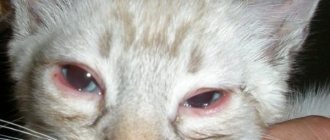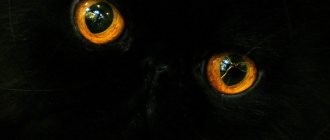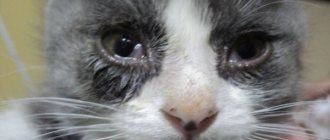Cat's eye syndrome, tetrasomy 22 or Schmid-Fraccaro disease are the names of one genetic pathology, which received its main name from its characteristic feature - the pupil in appearance resembles the pupil of a cat. This occurs due to a congenital anomaly of the iris, which, by the way, does not always manifest itself this way. The second name is due to the genetic cause of the disease. On chromosome 22, there is some change in the form of an additional chromosome, or a partial addition to the normal one. In some cases, the disease is hereditary due to cell incompatibility or the carriage of such a mutation in one of the parents. Sometimes it is simply a malfunction during the formation of the reproductive cells of the father or mother. This genetic anomaly is extremely rare. Only 1 case per million children born.
What is cat eye syndrome?
Cat eye syndrome (abbreviated SKG or also cat pupil syndrome , Schmid-Fraccaro syndrome ) is a rare chromosomal disorder that occurs in humans at birth. People with a normal chromosome count have two 22 chromosomes, both of which have a short arm known as 22p and a long arm known as 22q. However, in people with SCH, the short arm and a small portion of the long arm of chromosome 22 (i.e. 22pter-22q11) are present 4 times rather than twice (partial tetrasomy). In a small number of people with cat pupil syndrome, 22q11 is present in triplicate (partial trisomy).
The name "cat's eye syndrome" comes from a distinctive ocular abnormality present in just over half of sufferers. This defect, known as a coloboma, usually appears as a cleft or slit in the iris below the pupil, and therefore the pupil resembles the appearance of a cat's eye.
However, there are other signs and symptoms associated with SCH, affecting many organs and systems. These symptoms result from abnormal development during the embryonic stage. Associated symptoms vary greatly in presence and severity from one person to another, including among members of the same family. Cat pupil syndrome is best thought of as a spectrum of disorders. While some patients may have few or mild signs, others may have multiple, severe malformations.
Treatment options
At the moment, methods for treating this pathology have not yet been developed.
In modern medicine, there are no therapeutic methods for the treatment of genetic diseases. Therefore, there is no treatment for cat pupil syndrome. But there are medical recommendations for preventing the development of pathology and ways to help sick children. To do this you need:
- Take a test to determine the genetic compatibility of partners before conceiving a child.
- Consult a geneticist if there is a family history of this disease.
- It is mandatory to undergo perinatal diagnostics in the 1st, 2nd, 3rd trimester: ultrasound and blood tests.
- When a sick child is born, medical actions can only help improve his quality of life.
- A newborn with cat pupil syndrome must undergo proctoplasty in the first days.
In addition, such children must be examined by specialized specialists: a surgeon, nephrologist, cardiologist, endocrinologist, orthopedist.
If cat pupil syndrome is present, doctors cannot give any prognosis. No one knows how a child with a genetic disease will develop and how long he will live. This depends on the severity of the pathology and the extent of damage to internal organs.
With timely detection of the disease, provision of adequate medical care, advising care and rehabilitation, the quality of life of such people increases significantly.
Signs and symptoms
Classic symptoms associated with SCH are ocular coloboma, anal atresia, and minor preauricular ear defects (see below). However, the syndrome is extremely variable, and it has been estimated that only 41% of patients with SCH have this classic triad of symptoms. In general, abnormalities associated with SCG tend to affect the eyes, ears, anal area, heart, kidneys, etc. organs, and some people experience intellectual (mental) disabilities.
The most common signs of cat pupil syndrome are discussed below. Some patients may show few or no symptoms, making the disorder difficult to diagnose.
—Coloboma and other visual impairments.
Coloboma is characterized by partial absence of eye tissue (see photo), often of both eyes (bilateral). Occurs due to the failure of cracks in the lower part of the eye to close during early development, resulting in a persistent cleft or tear. Affected is the colored part of the eye that controls the amount of light that enters the eye (iris), the dark brown, middle layer (choroid), and/or the nerve-rich inner membrane (retina) of the eye.
Iridescent coloboma can give the iris an unusual "keyhole" appearance. If only the iris is involved, vision is not affected. However, more extensive coloboma involving other layers of the eye can lead to visual defects and/or blindness. Although coloboma was initially considered a core feature of the disorder, this abnormality is present in only half of patients with SCH.
Some victims have additional visual impairments, including:
- unequal direction of the eye pupils (strabismus);
- abnormal smallness of one of the eyeballs (unilateral microphthalmia).
Less commonly, other eye defects may be present, including:
- absence of the iris (aniridia);
- clouding of the dome-shaped, usually clear area at the front of the eyeball (cornea);
- lack of tissue in areas of the eyelid (coloboma of the eyelid);
- loss of transparency of the lens of the eye (cataract)
- Duane syndrome (a rare congenital type of strabismus).
The latter is a condition characterized by the restriction or absence of certain horizontal movements of the eye and the retraction or “retraction” of the eyeball into the eye cavity (orbit) when trying to look inside. In some cases, depending on the severity and/or combination of eye abnormalities present, varying degrees of visual impairment, including blindness, are possible.
- Anal abnormalities.
In about a quarter of people, the anus may be unusually small or narrow (anal stenosis) or the anal canal may be absent (anal atresia), sometimes with a passage (fistula) from the end of the large intestine (rectum) to the wrong places. In men, fistulas can form between the rectum and the muscular organ that collects urine (bladder), the tube that drains urine from the bladder (urethra), or the area behind the genitals (perineum). In women, fistulas may be present between the rectum and the bladder or vagina. Anal atresia and fistulas are corrected surgically.
- Hearing impairment.
The third classic feature of SCH is preauricular ear defects. This is the most common feature of SCH, observed in more than 80% of people. Patients may have small skin growths and/or small indentations (pits) in front of the outer ears (see photo). In addition, the outer parts of the ears (pinnae) may be low-set and/or abnormally shaped, sometimes with mixed or missing outer ear canals (microtia). In most cases, the absence (atresia) of the external auditory canal tends to affect one ear and can cause mild hearing loss due to inadequate transmission of sound from the outer to the inner ear (conductive hearing loss).
How are eye diseases treated in cats?
When the first symptoms of various ailments appear, you should take your pet to the veterinarian. The doctor will take all the necessary tests and help you choose a treatment that can be carried out at home. To monitor their general condition, furry patients should also come for regular check-ups; therapy will be adjusted as needed. To avoid additional eye injury, you need to put a special tight collar on your cat. It will help protect the affected area from scratching and ensure that the medicine lasts longer.
Protective collar prevents additional injury
Table: pharmaceutical products to combat pathologies
| Drug name | Drug group | What diseases is it used to treat? | Release form | Compound | Can it be used in kittens and pregnant cats? | Product price |
| Mizofen-F | Antibiotics and antiparasitics | Conjunctivitis and infected wounds | Ointment | Chloramphenicol, Levomisole | Yes | RUR 342 |
| Tetracycline ointment 1% | Antibiotics | Conjunctivitis, blepharitis, keratitis (caused by bacteria), infected wounds and burns | Ointment | Tetracycline | 110 RUR | |
| Leopard | Conjunctivitis, blepharitis, keratitis | Eye drops | Furacilin, Levomycetin | 150 RUR ( | ||
| Phytoelite | Means for preventive eye treatment | Tearing | Eye lotion | Purified water, chamomile | 120 RUR | |
| Betamox | Antibiotics | Inflammatory eye diseases, infected wounds and injuries | Suspension for injection | Amoxicillin trihydrate | With caution (if the benefit outweighs the possible harm) | 510 RUR |
| Amoxiclav | Pills | Amoxicillin and clavulanic acid | 400 RUR | |||
| Alphagan P | Alpha adrenergic agonists | Glaucoma | Eye drops | Brimonidine | No | RUR 666 |
| Combigan | Brimonidine and Timolol | RUR 783 | ||||
| Lacrimin prophylactic | Means for preventive eye treatment | Watery eyes, conjunctivitis | Eye drops | Sodium chloride, ammonium fluoride | Yes | 250 RUR |
Photo gallery: pharmaceutical products to combat eye diseases
Alphagan P lowers intraocular pressure
Bars drops effectively cope with inflammatory eye diseases
Betamox destroys germs
Mizofen-F helps relieve swelling and inflammation
How to give medications correctly
For a pharmaceutical drug to start working, it must be used correctly. Before starting the procedure, it is recommended to hold the cat in your arms for a while so that the animal calms down.
Try to prevent your pet from seeing cotton pads, syringes, drops and medicine packages: this can negatively become embedded in his memory and cause severe stress in the future.
How to properly treat an animal:
- Instillation of drops. Before starting the procedure, clean the upper and lower eyelids from crusts using cotton wool soaked in boiled water. After this, pull back the lower eyelid and drop drops into the resulting gap. If necessary, remove residue with a cotton pad. Hold the animal for several minutes to prevent the cat from scratching its eyes or washing its face.
- Applying ointment. Also pull back the lower eyelid, then use a sterile glass rod to place the required amount of ointment there and distribute. Next, you need to put a special collar on your furry patient.
- Use of tablets. Using a mortar, grind them to a powder or small pieces, then mix with food. You can also dissolve the medicine in water, if this does not lose its healing properties.
- Setting up the injection. For this procedure, you will need an assistant to hold the cat. Intramuscular and subcutaneous injections are placed at the withers. To do this, gather a fold in the area where the neck meets the back, insert a needle and slowly inject the drug. The placement of IVs and intravenous injections is carried out only by veterinarians.
Folk remedies for washing the eyes of cats
To get rid of the unpleasant symptoms of inflammatory diseases, you can use natural recipes based on various plants and herbs. They also have a healing effect, but have less impact on the pet’s body.
Do not forget that the use of folk remedies should also be coordinated with a veterinarian.
Most popular recipes:
- Brew 2 teaspoons of dried chamomile in a glass of boiling water, cool to room temperature. Use your pet's eye wash 2 times a day. Chamomile has an anti-inflammatory effect and relieves swelling, itching and burning, which helps get rid of blepharitis and keratitis.
- Brew 5-7 tea bags in a glass of boiling water. Leave for 6 hours, then treat the animal’s eye at least twice. Brewing allows you to quickly cope with the main symptoms of conjunctivitis in a cat.
- Pour 10 g of elderflowers and 20 g of cornflowers into 0.5 liters of liquid and cook for half an hour. After cooling to room temperature, rinse (preferably in the evening). These plants have antiseptic and antibacterial properties, which allows them to be used during suppuration.
Photo gallery: folk remedies to eliminate symptoms of the disease
Chamomile relieves itching and inflammation
Tea brewing is effective in the fight against conjunctivitis
Elderberry flowers cope with suppuration
How to wash your eyes
Eye wash algorithm:
- Prepare cotton pads, gauze and medicinal solution. The temperature of the product should be no lower than room temperature so as not to cause a stress reaction. Wash your hands with soap.
- Take the animal and calm it down (an assistant can do this). Dip a cotton pad or gauze into the solution and squeeze out.
- Use the fingers of one hand to open your furry patient's eyelids. Using light pressure, move from the inner corner of the eye to the outer corner, removing dirt. After this, take a clean swab and perform the procedure again. At the end, you need to remove the remaining product with gauze.
In some cases, you can wash your eyes using a syringe without a needle. To do this, add the product there and irrigate the animal’s eye under low pressure. After completing the procedure, blot the upper and lower eyelids.
Based on my own experience, I advise you to trim the animal’s claws before washing your eyes. One of my furry pets has a very difficult time with such procedures, as a result of which even two people cannot hold him. One day I forgot to cut the cat’s claws: my assistants received rather unpleasant injuries.
Video: doctor talks about how to properly wash animals' eyes
Causes of cat eye syndrome
Cat pupil syndrome is a rare disorder caused by the presence of an extra piece of chromosome in which the short arm (p) and a small part of the long arm (q) of chromosome 22 are usually present in four copies (partial tetrasomy) rather than two copies in the body's cells .
Chromosomes are found in the nucleus of all cells in the body. They carry the genetic characteristics of every person. The pairs of human chromosomes are numbered 1 to 22, plus two X chromosomes in women and a 23rd pair of X and Y chromosomes in men. Each chromosome has a short arm, designated "p", a long arm, designated "q", and a narrow region where the two arms are connected (the centromere). The chromosomes are further divided into bands numbered outward from the centromere. For example, the short arm of chromosome 22 includes bands 22p11.1 to 22p13; the end of the short arm is known as 22pter. The long arm (shoulder) includes bands from 22q11.1 to 22q13.
Thus, people with normal chromosomal structure have two 22 chromosomes, each consisting of a short arm (22p), a long arm (22q) and a centromere. However, almost all people with cat eye syndrome have an unusual extra chromosome (a bisatellite marker chromosome). This marker chromosome comes from two segments of chromosome 22, each consisting of a short arm, a centromere, and part of a long arm (22q11), both fused together to form one extra chromosome. Therefore, this chromosomal region (22pter-22q11) is present four times in the body's cells: twice as part of two normal chromosomes 22 and twice together on a marker chromosome. Additionally, in some people, this extra chromosome may be present in only a certain percentage of the body's cells (mosaicism).
In rare cases, part of the chromosomal segment 22q11 may appear three times: once on normal chromosome 22 and twice on chromosome 22 with an internal duplication. Part of the 22q11 region is considered critical for the expression of all or most of the features associated with SCH. This region is referred to as the SKG critical region and contains approximately 12 genes.
The exact cause of cat eye syndrome is not understood. In most cases, the chromosomal abnormality appears to occur accidentally due to an error in the division of the parent's reproductive cells (meiotic error); in such cases the parent has normal chromosomes. The formation of a marker chromosome may result from specific sequences in the region that predispose to chromosomal rearrangement. This is not related to any specific parental actions during pregnancy.
A small percentage of parents (especially those with milder symptoms) will pass on the SKG chromosome to their offspring. In some of these cases, the parent has a marker chromosome in some cells of the body while other cells in the body are unaffected (mosaicism). There have been cases where mosaicism for this chromosomal abnormality could be passed down through several generations; however, as noted above, the expression of associated traits may be variable. As a result, people with multiple or severe symptoms may be identified while the previous generation remains unrecognized and undiagnosed. In any case, it is important to note that people with the syndrome who have children are at significant risk of passing on the extra marker chromosome to their offspring.
What causes the syndrome?
This is a genetically determined pathology. One of the parents may be asymptomatic. You may not even be aware that you have an extra chromosome. But the risk of developing the disease in a child is 90%. If there is a predisposition to the syndrome, it can be provoked by medications that a woman takes during gestation, or by infectious diseases suffered by the pregnant woman. These factors contribute to the occurrence of structural changes in the fetus.
There are other reasons: exogenous and endogenous. In the first case, we are talking about poor ecology, bad habits, chronic fatigue, long-term use of antibiotics or hormonal drugs. Internal factors include:
- intoxication;
- chronic somatic pathologies;
- weak immunity;
- acute infectious diseases.
Affected Populations
SKG was recognized more than a century ago. More than 100 cases have been described in the medical literature, including apparently sporadic and familial cases. There are many more victims, but they are not described in the medical literature. However, the syndrome is very rare, and there are currently no accurate estimates of the prevalence of SCH in the population. In 1981, cat eye syndrome was estimated to affect 1 in 50,000 to 1 in 150,000 people. It affected both men and women. However, because some people have few associated symptoms, their disorder may go unrecognized. There is currently no way to assess how underdiagnosed this syndrome is.
Cat eye glow effect
A cat walking in a dark room or along the street at night can cause a certain frightening sensation, a slight horror. Her eyes “glow” with a greenish, yellowish or even red light. Scientists have long learned the secret of this phenomenon. The “glow” of a cat’s eyes comes from a layer of blood vessels located on the eyeballs behind the retina. This shell is called tapetum. It has a reflective property, which creates a glowing effect.
Photons penetrate the retinal tissue and are captured by the tapetum, which reflects the rays. Nature did not give this property to cats in order to provide them with a mysterious, mystical appearance. It is thanks to the presence of the tapetum that animals are ideally oriented in the dark, since the retina of the eye receives significantly more light compared to the human eye under the same lighting conditions. To distinguish objects, fluffies need illumination six times less than for humans. Cats are predators, and they need keen vision at night for successful hunting. It also serves as protection against sudden attacks by enemies and allows you to detect danger in a timely manner.
The tapetum cannot glow; the effect is created only when photons from a natural or artificial light source hit the shell. If the cat is in complete darkness, there will be no mystical sparkle in the eyes. But it will still be able to navigate perfectly, since the animal is helped by its well-developed sense of smell, hearing, and touch.
Diagnostics
The diagnosis of SCH is based on the presence of extrachromosomal material derived from chromosome 22q11.
It is possible that the diagnosis of FBS may be suspected before birth (in utero) based on specialized tests such as ultrasound, amniocentesis and/or chorionic villus sampling. During a fetal ultrasound, reflected sound waves create an image of the developing fetus, potentially revealing certain defects, such as a heart defect, that may indicate SCG. During amniocentesis, a sample of amniotic fluid containing fetal cells is removed and analyzed. A chorionic villus sampling removes a sample of tissue from part of the placenta. Chromosomal studies performed on such cells can reveal the SKG chromosome.
Treatment of cat eye syndrome
Treatment of cat eye syndrome may require the coordinated efforts of a team of medical specialists such as pediatricians, surgeons, cardiologists, gastroenterologists, ophthalmologists; health professionals who identify, evaluate and help manage hearing problems; doctors who diagnose and treat disorders of the skeleton, muscles, joints and related tissues (orthopedists); and/or other healthcare professionals.
Treatment of the disease is aimed at the specific symptoms that appear in each person. People with congenital heart defects may require treatment with certain medications, surgery, and/or other measures. In addition, surgical correction is necessary for anal atresia. In some cases, recommended treatment may also include surgical repair, correction, or treatment of certain ocular defects, skeletal abnormalities, genital defects, hernias, Hirschsprung's disease, biliary atresia, and/or other malformations associated with the disorder. Specific surgical procedures may depend on the size, nature, severity, and/or combination of anatomical abnormalities; associated symptoms; patient's age; and other factors.
Before and after surgery for certain heart defects, people may be susceptible to bacterial infection of the lining of the heart and valves (endocarditis). Therefore, prophylactic antibiotic therapy may be prescribed before and after certain surgical procedures and dental visits. In addition, respiratory infections must be treated quickly and at an early stage.
For people with certain skeletal disorders, treatment may include physical therapy and various orthopedic treatments, possibly including surgical measures. Additionally, people with growth problems combined with a deficiency of growth hormone in the body may be prescribed growth hormone therapy.
Early intervention is important for children with SCH to reach their potential. Special services that may be helpful include special education, special social support, and/or other health, social, and/or vocational services.
Genetic counseling will also be helpful for affected individuals and their families. Chromosomal testing may be recommended to parents of affected children to determine whether they carry the SCH chromosome or exhibit mosaicism, especially if they exhibit any features that may be associated with the disorder. Genetic counseling can also be helpful for adults with FBS who want to have children.











